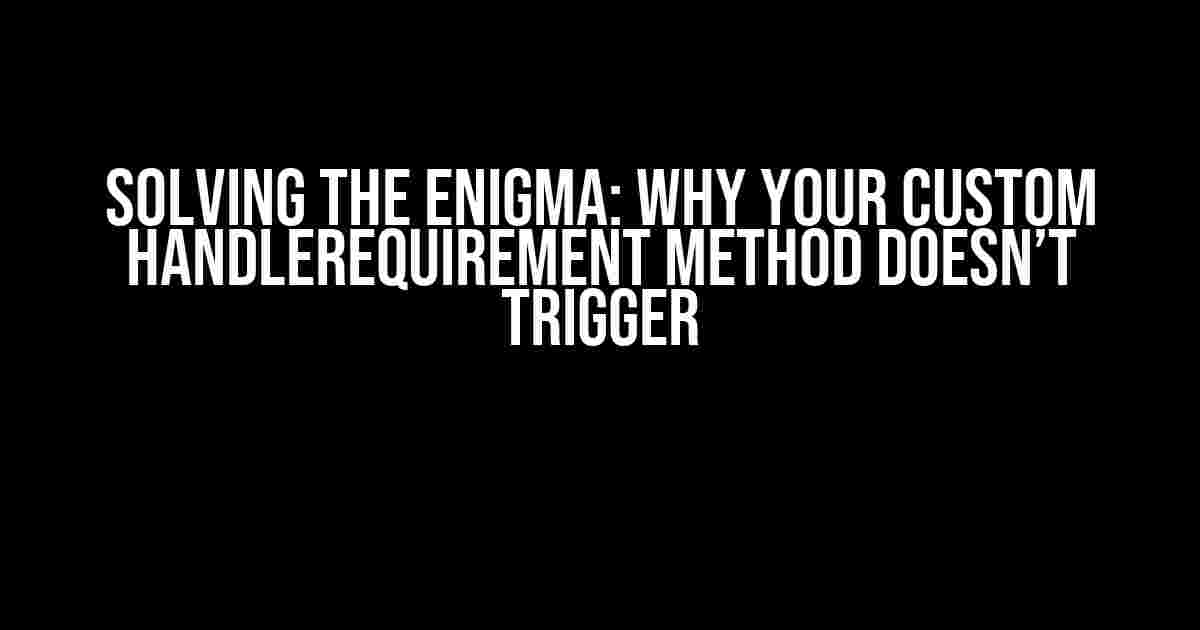If you’re reading this article, chances are you’ve encountered the frustrating issue of your custom HandleRequirement method refusing to trigger. Don’t worry, you’re not alone! In this comprehensive guide, we’ll dive into the world of ASP.NET Core and explore the reasons behind this conundrum. By the end of this article, you’ll be equipped with the knowledge to debug and fix the issue, ensuring your custom HandleRequirement method works seamlessly.
Understanding the HandleRequirement Method
The HandleRequirement method is an essential component of ASP.NET Core’s policy-based authorization system. It allows developers to create custom authorization handlers that can evaluate a specific requirement and determine whether the user has access to a particular resource. In a typical implementation, the HandleRequirement method is called by the authorization middleware, which then returns a success or failure result based on the handler’s evaluation.
public class CustomRequireClaimHandler : AuthorizationHandler<CustomRequireClaim>
{
protected override async Task HandleRequirementAsync(AuthorizationHandlerContext context, CustomRequireClaim requirement)
{
// Your custom logic goes here
}
}Troubleshooting the Issue: Why Your Custom HandleRequirement Method Doesn’t Trigger
Now that we’ve covered the basics, let’s dive into the potential reasons why your custom HandleRequirement method isn’t triggering as expected. We’ll explore each scenario in detail, providing you with a step-by-step guide to identify and resolve the issue.
Scenario 1: Missing or Incorrect Registration
The first and most common mistake is incorrect registration of the custom authorization handler. Make sure you’ve registered your handler in the DI container during the application startup.
public void ConfigureServices(IServiceCollection services)
{
services.AddAuthorization(options =>
{
options.AddPolicy("MyPolicy", policy =>
{
policy.Requirements.Add(new CustomRequireClaim());
});
});
services.AddSingleton<IAuthorizationHandler, CustomRequireClaimHandler>();
}In the above code, we’ve registered the CustomRequireClaimHandler as a singleton instance, and added a policy with the custom requirement.
Scenario 2: Incorrect Implementation of the HandleRequirement Method
The HandleRequirement method is called by the authorization middleware, and it’s essential to implement it correctly. Ensure that your method is correctly overriding the base class method and is marked as protected override.
public class CustomRequireClaimHandler : AuthorizationHandler<CustomRequireClaim>
{
protected override async Task HandleRequirementAsync(AuthorizationHandlerContext context, CustomRequireClaim requirement)
{
if (!context.User.HasClaim(c => c.Type == requirement.ClaimType))
{
context.Fail();
}
else
{
context.Succeed(requirement);
}
}
}In this example, we’re overriding the HandleRequirementAsync method, checking if the user has the required claim, and failing or succeeding the authorization context accordingly.
Scenario 3: Conflicting Requirements
When multiple requirements are added to a policy, they are evaluated in the order they are added. If a requirement fails, the subsequent requirements are not evaluated. Ensure that your custom requirement is not being overridden by another requirement.
options.AddPolicy("MyPolicy", policy =>
{
policy.Requirements.Add(new CustomRequireClaim());
policy.Requirements.Add(new DenyAnonymousRequirement());
});In this example, the DenyAnonymousRequirement might be overriding your custom requirement. Try reordering the requirements or removing conflicting ones to ensure your custom requirement is evaluated correctly.
Scenario 4: Incorrect Usage of the Authorization Middleware
The authorization middleware must be added to the request pipeline in the correct order. Ensure that the middleware is added after the authentication middleware and before the MVC middleware.
public void Configure(IApplicationBuilder app, IWebHostEnvironment env)
{
app.UseRouting();
app.UseAuthentication();
app.UseAuthorization();
app.UseEndpoints(endpoints =>
{
endpoints.MapControllers();
});
}Scenario 5: Missing Claim or Incorrect Claim Type
If your custom requirement is checking for a specific claim, ensure that the claim is present in the user’s principal and the claim type is correct.
[Authorize(Policy = "MyPolicy")]
public IActionResult MyAction()
{
var claims = HttpContext.User.Claims.ToList();
foreach (var claim in claims)
{
Console.WriteLine($"Type: {claim.Type}, Value: {claim.Value}");
}
return View();
}In this example, we’re logging the user’s claims to the console, helping you identify if the required claim is present and correctly typed.
Best Practices for Implementing Custom Authorization Handlers
Now that we’ve covered the common pitfalls, let’s discuss some best practices for implementing custom authorization handlers:
- Keep your handlers simple and focused on a specific requirement.
- Use a clear and concise naming convention for your handlers and requirements.
- Test your handlers thoroughly to ensure they’re working as expected.
- Use the built-in diagnostic tools to debug your authorization pipeline.
- Avoid complex logic in your handlers, instead, consider using a separate service to evaluate the requirement.
Conclusion
In this comprehensive guide, we’ve explored the reasons behind the frustrating issue of a custom HandleRequirement method not triggering. By following the steps outlined in this article, you should be able to identify and resolve the issue, ensuring your custom authorization handler works seamlessly. Remember to keep your handlers simple, test them thoroughly, and avoid common pitfalls to ensure a robust and secure authorization system.
| Scenario | Description | Solution |
|---|---|---|
| Missing or Incorrect Registration | Custom authorization handler not registered correctly. | Register the handler in the DI container and add the policy with the custom requirement. |
| Incorrect Implementation of the HandleRequirement Method | HandleRequirement method not implemented correctly. | Override the base class method and mark it as protected override. |
| Conflicting Requirements | Multiple requirements conflict with each other. | Reorder the requirements or remove conflicting ones. |
| Incorrect Usage of the Authorization Middleware | Authorization middleware not added correctly to the request pipeline. | Add the middleware after the authentication middleware and before the MVC middleware. |
| Missing Claim or Incorrect Claim Type | Claim not present in the user’s principal or incorrect claim type. | Ensure the claim is present and correctly typed. |
By following these guidelines and best practices, you’ll be well on your way to creating robust and secure custom authorization handlers that meet your application’s specific needs.
Frequently Asked Question
Custom HandleRequirement method not triggering? Don’t worry, we’ve got you covered! Here are some common questions and answers to help you troubleshoot the issue.
Why is my custom HandleRequirement method not being called?
Make sure you’ve registered your custom requirement handler in the DI container. You can do this by adding services.AddTransient
Is there a specific order in which I should register my custom handlers?
Yes, the order of registration matters! You should register your custom handlers after the AddAuthentication and AddAuthorization services in the ConfigureServices method. This ensures that your custom handlers are executed after the default handlers.
How do I debug my custom HandleRequirement method?
Use a debugger! Set a breakpoint in your custom HandleRequirement method and run your application in debug mode. This will help you identify if the method is being called and what’s happening inside it. You can also use logging or tracing to monitor the execution flow.
Can I use multiple custom handlers for a single requirement?
Yes, you can! You can register multiple custom handlers for a single requirement. The handlers will be executed in the order they’re registered. Just keep in mind that if one handler returns a success or failure result, the subsequent handlers won’t be executed.
How do I unit test my custom HandleRequirement method?
Use a testing framework like xUnit or NUnit to write unit tests for your custom handler. You can mock the necessary dependencies and pass in test data to verify the method’s behavior. This will help you ensure your custom handler works as expected in different scenarios.


